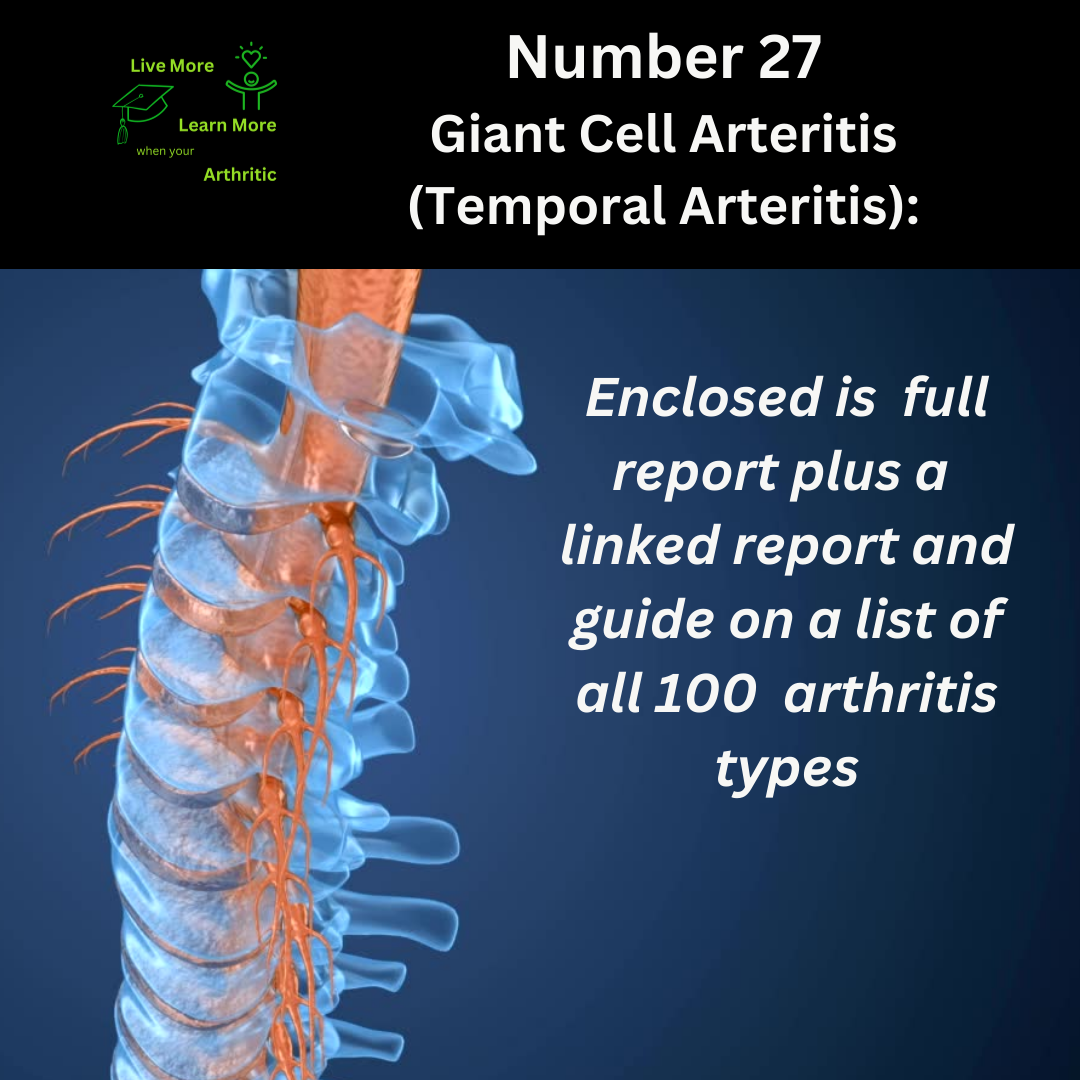
Giant Cell Arteritis (Temporal Arteritis): Number 27 on the list of 100 types of Arthritis
Giant Cell Arteritis (Temporal Arteritis): Unveiling the Mysteries
In the world of health and medicine, some conditions are as enigmatic as they are impactful. Giant Cell Arteritis (GCA), also known as Temporal Arteritis, falls squarely into this category. It’s a complex disease that can affect individuals profoundly, yet many remain unaware of its nuances. Let’s embark on a journey to demystify this condition, exploring its characteristics, impact, and potential paths to a brighter future.
Giant Cell Arteritis is an inflammatory disease that primarily affects the medium and large arteries of the head, particularly the temporal arteries (hence the name Temporal Arteritis). This condition is characterized by inflammation of the blood vessel walls, leading to various symptoms and potential complications. It’s often considered a vasculitis, a condition involving inflammation of blood vessels.
The Heart of the Matter: Causes and Triggers
The exact cause of Giant Cell Arteritis remains elusive. However, there are strong indications that it involves an abnormal immune response. It’s widely believed to be an autoimmune disorder, where the body’s immune system mistakenly attacks its own tissues, in this case, the arteries.
Triggers for Giant Cell Arteritis are not definitively known, but some theories suggest a combination of genetic predisposition and environmental factors. Interestingly, there may be a link to certain infections, though research is ongoing in this area.
The Tell-Tale Signs: Symptoms and Effects
Recognizing Giant Cell Arteritis is crucial for timely intervention. The hallmark symptoms often include severe headaches, tenderness or pain in the temples, visual disturbances, and sometimes jaw pain, especially while chewing. Fatigue and malaise can also accompany these symptoms.
One distinctive feature is the potential for vision loss, making this a particularly concerning condition that demands prompt medical attention.
Who is Affected and How?
Giant Cell Arteritis primarily targets older adults, with the average age of onset around 70 years. However, it can occur in individuals as young as 50. Interestingly, women are more commonly affected than men, though the reasons for this gender bias remain unclear.
Embracing Hope: Proactive Approaches and Quality of Life
While Giant Cell Arteritis can be a serious condition, proactive management can significantly improve outcomes and quality of life. A proactive approach involves regular monitoring, adherence to treatment plans, and lifestyle modifications that support overall well-being.
For instance, maintaining a balanced diet, staying physically active within safe limits, and managing stress effectively can all contribute to a higher quality of life for individuals with GCA.
Potential Complications: Navigating the Risks
Left untreated or inadequately managed, Giant Cell Arteritis can lead to severe complications. The most worrisome is permanent vision loss due to damage to the arteries supplying blood to the eyes. Other complications may include stroke, aneurysm, or even aortic dissection in severe cases.
 Looking Beyond: Holistic Perspectives and Emerging Insights
Looking Beyond: Holistic Perspectives and Emerging Insights
In the pursuit of improved outcomes, holistic approaches are gaining attention. While no holistic or all-natural breakthroughs can replace medical intervention, certain lifestyle changes and complementary therapies may support conventional treatments.
For instance, mindfulness practices, such as meditation or yoga, can aid in stress reduction, which is crucial for managing autoimmune conditions like GCA. Additionally, a nutrient-dense diet rich in antioxidants and anti-inflammatory foods may provide supplementary support.
Connecting the Dots: Interconnected Conditions
Giant Cell Arteritis isn’t an isolated concern. It’s often associated with other autoimmune disorders, such as rheumatoid arthritis or polymyalgia rheumatica. Awareness of these interconnected conditions is essential for comprehensive care and effective management.
In conclusion, Giant Cell Arteritis presents challenges but also opportunities for informed action. By understanding its nature, symptoms, and potential impact, individuals and healthcare professionals can collaborate to navigate this intricate landscape. With proactive approaches, holistic perspectives, and ongoing research, the journey toward better outcomes continues—a journey fueled by compassion, knowledge, and hope.
